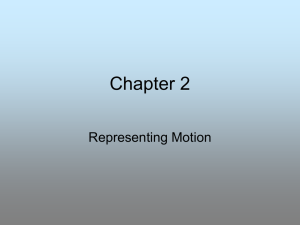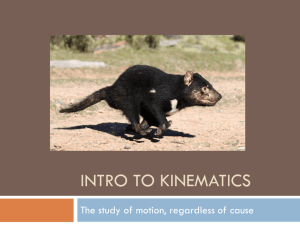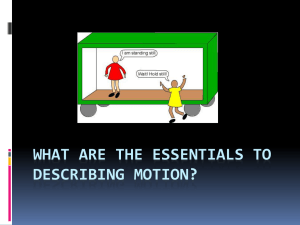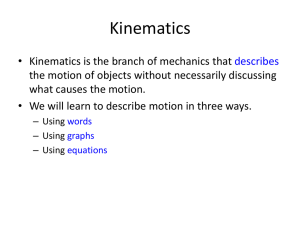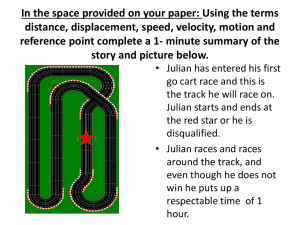Motion can be described using graphs.
advertisement
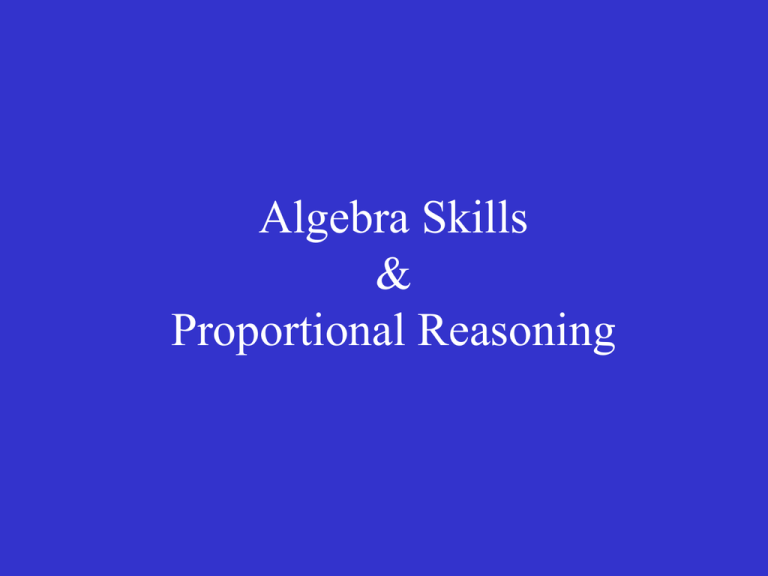
Algebra Skills & Proportional Reasoning Rearranging • One of the tasks that physics requires is being able to rearrange equations. • Remember:The reason for rearranging is to isolate the variable that you are looking for. • Basic Rule: What you do to one side of the equation, you must do to the other side also. Example: v = d/t Solve for d • Multiple both sides by t. The t’s on the right hand side cancel leaving d. • Therefore, d = vt • Solve for t • Again, multiply both sides by t and divide both sides by v. • Therefore, t = d/v Example: d = ½ g Solve for time. • • • • • • Multiple both sides by 2 2d = gt2 Divide both sides by g 2d/g = t2 Square root both sides. T = √(2d/g) 2 t Example: E = mgh + ½ Solve for m • E = m(gh + ½ v2) • m = E/(gh + ½ v2) 2 mv Example 2: E = mgh + ½ Solve for h • E – ½ mv2 = mgh • h = (E – ½ mv2 )/mg 2 mv Example 3: E = mgh + ½ Solve for v • • • • E – mgh = ½ mv2 2(E – mgh ) = mv2 2(E – mgh )/m = v2 v = √[2(E – mgh )/m] 2 mv Example 4: Solve by Substitution 2x + 8y = 1 x = 2y Unsolvable on its own…. But if two equations are known… Solve for x and y Since x = 2y, you can insert 2y wherever x occurs. Now you can solve for x: 2(2y) + 8y = 1 4y + 8y = 1 12y=1 x = 2y y = 1/12 y = 1/6 y = 1/12 x = 2(1/12) Describing Motion • • • • Motion can be described using words. Motion can be described using diagrams. Motion can be described using equations. Motion can be described using graphs. Vocabulary: Scalar vs. Vector A scalar quantity has magnitude only. – Examples: distance, temperature A vector quantity has magnitude and direction. – Examples: force, acceleration. Symbols for vector quantities are written in bold or with an arrow above them: a Beginning Question: A teacher walks 5.0m north of his desk, and then turns around and walks 6.0m south. How far has the teacher gone? 11.0m? … or 1.0m? “How far has he gone” is not clear enough. We need to distinguish between Distance vs. Displacement Vocabulary: Distance: How far an object has traveled A scalar quantity: has magnitude only. Displacement: Change in position A vector quantity: has magnitude and direction. Displacement d d1 d0 most common notation or or or x xf xi y y1 y0 r1 r0 r • • • • Motion can be described using words. Motion can be described using diagrams. Motion can be described using equations. Motion can be described using graphs. http://acme.highpoint.edu/~atitus/physlets/index.html …but always depends on a FRAME OF REFERENCE. …………………..assign a coordinate system. Sample problem #1 A teacher walks 5.0m north of his desk. What is the teacher’s displacement? The desk is at xi = 0.0m The teacher’s final position, xf = 5.0m north The displacement, x = xf – xi x = 5.0m – 0.0m x = 5.0m Sample problem #2 Find the displacement of the gecko. Sample problem #3 Find the displacement of the gecko. If a displacement is written without a direction stated, assume it is in the x – direction. eg: d = 54.9 m Sample problem #4 A teacher walks 5.0m north of his desk. He then walks 6.0m south. What is the teacher’s displacement in reference to his desk? What is the total distance the teacher has walked? Forget about the formula and think this through. If north is positive and south is negative, then x = 5.0m – 6.0m = -1.0m or 1.0m south of the desk Sample problem #4 A teacher walks 5.0m north of his desk. He then walks 6.0m south. What is the teacher’s displacement in reference to his desk? What is the total distance the teacher has walked? Distance = total amount traveled Distance = 5.0m + 6.0m = 11.0m walked Notice how the direction is not considered. Distance vs. Displacement 5.0m North Distance vs. Displacement 6.0m South Distance vs. Displacement 1.0m South 5.0m North 6.0m South The displacement tells you where the teacher ended up. The distance tells you the total length of his journey. Changing position over time http://acme.highpoint.edu/~atitus/physlets/index.html How fast is an object moving? Average Velocity: v v – displacement : time ratio – A vector quantity: has magnitude and direction. – total displacement : total time elapsed Average Speed: s – distance : time ratio – A scalar quantity: has magnitude and direction. – total distance : total time elapsed Average Velocity v d t d1 d0 t1 t0 Velocity vs. Speed Velocity is a vector Velocity = displacement time Speed is a scalar (direction does not matter) Speed = distance time Speed and Velocity Can an object have a velocity that is changing while the speed remains the same? Can an object have a speed that is changing while the velocity remains the same? Constant Velocity Constant velocity is when an objects velocity remains the same for a given amount of time. Instantaneous Velocity Instantaneous velocity is the velocity at a given point in time. Example: Speedometer, Radar gun Sample Problem #5 Suzy Physics Student lives 5.0miles south of school. If she takes 2.0 hours to get to school, what is Suzy’s average velocity? Sample Problem #6 Suzy Physics Student walks 5.0miles South to school. She takes 2.0 hours to get to school, realizes she is hungry and decides to walk for 1.0 hour to go 2.0 miles North to IHOP. What is Suzy’s average velocity for the whole trip? What is Suzy’s average speed for the whole trip? Sample Problem #7 Practice problems Practice problems Practice problems Practice problems Practice problems Linear Relationships: y = k x Slope 50 m=(40-8)/(50-10) Mass(g) 40 m=32/40 30 m=0.8 g/cm3 20 10 0 10 20 30 Volume(mL) 40 Interpolation vs. Extrapolation Graphing Motion • • • • Motion can be described using words. Motion can be described using diagrams. Motion can be described using equations. Motion can be described using graphs. Graphing Motion Graphs of Position vs. Time 1. Calculate the displacement 2. Calculate the velocity 3. Describe forward and reverse motion 4. Describe an object staying still Calculating displacement x, Position, (m) A position vs. time graph lets you calculate the displacement between any two moments: t, Time, (s) Calculating displacement x, Position, (m) Find the displacement between A and B A (0,0) B (1,5) Use x = xf ––xxii Where 5m– 0m xx= f =5m and xx=i =5m 0m t, Time, (s) Calculating displacement Find the displacement between C and D x, Position, (m) C (4,8) Use x x == xxff –x – xi i Wherexxf==3m 3m– 8m and xxi==-5m 8m t, Time, (s) D (8,3) Calculating displacement x, Position, (m) Find the displacement from when the object was moving for 2s to when it had been moving for 9s. 6m Use x = xf ––xxii 5m Where 6m– 5m xx= f =6m and xx=i =1m 5m 2s t, Time, (s) 9s Position vs. Time Graph What are the velocities? What are the velocities? Average Velocity on an x-t graph vav vs vinst on an x-t graph x-t graph vs motion of a particle Acceleration • • • • Motion can be described using words. Motion can be described using diagrams. Motion can be described using equations. Motion can be described using graphs. Terms Acceleration vs. Acceleration Acceleration: The rate at which velocity changes (vector) Acceleration: The rate at which speed changes (scalar) Symbol: a or a SI Unit: meters per second per second or meters per second squared, m/s/s or m/s2 Average Acceleration Velocity vs. Time Graph The slope of a v vs. t graph is the acceleration The area between the curve and the horizontal axis of a v vs. t graph is the displacement Instantaneous Acceleration vs Average Acceleration from a v-t graph v-t graph vs motion of a particle x-t graph vs motion of a particle with acceleration What are the accelerations and displacements? What are the accelerations and displacements? Acceleration vs. Time Graph The slope means NOTHING The area between the curve and the horizontal axis is the change in velocity a 10 s -10 m/s/s t Important Acceleration tells us how fast velocity changes Velocity tells us how fast position changes Kinematics Equations (accelerated motion) Falling Bodies, thrown up objects, and the y-direction All things fall at the same rate (neglecting air resistance) On earth that rate is 9.80 m/s2 That rate is an acceleration The name of that acceleration is Gravity Object moving in y-dir

